Abstract
The emergence of influenza A viruses which had acquired resistance to rimantadine during a clinical trial (C. B. Hall, R. Dolin, C. L. Gala, D. M. Markovitz, Y. Q. Zhang, P. H. Madore, F. A. Disney, W. B. Talpey, J. L. Green, A. B. Francis, and M. E. Pichichero, Pediatrics 80:275-282, 1987) provided the opportunity to determine the genetic basis of this phenomenon. Analysis of reassortant viruses generated with a resistant clinical isolate (H3N2) and the susceptible influenza A/Singapore/57 (H2N2) virus indicated that RNA segment 7 coding for matrix and M2 proteins conferred the resistant phenotype. Resistant viruses isolated from seven patients each contained a single change in the nucleotide sequence coding for the M2 protein which resulted in substitutions in amino acid 30 (two viruses) or 31 (five viruses) in the transmembrane domain of the molecule. These changes occurred in locations identified in influenza viruses selected for resistance to amantadine in tissue culture and indicate a common mechanism of action of the two compounds in cell culture and during chemotherapeutic use.
Full text
PDF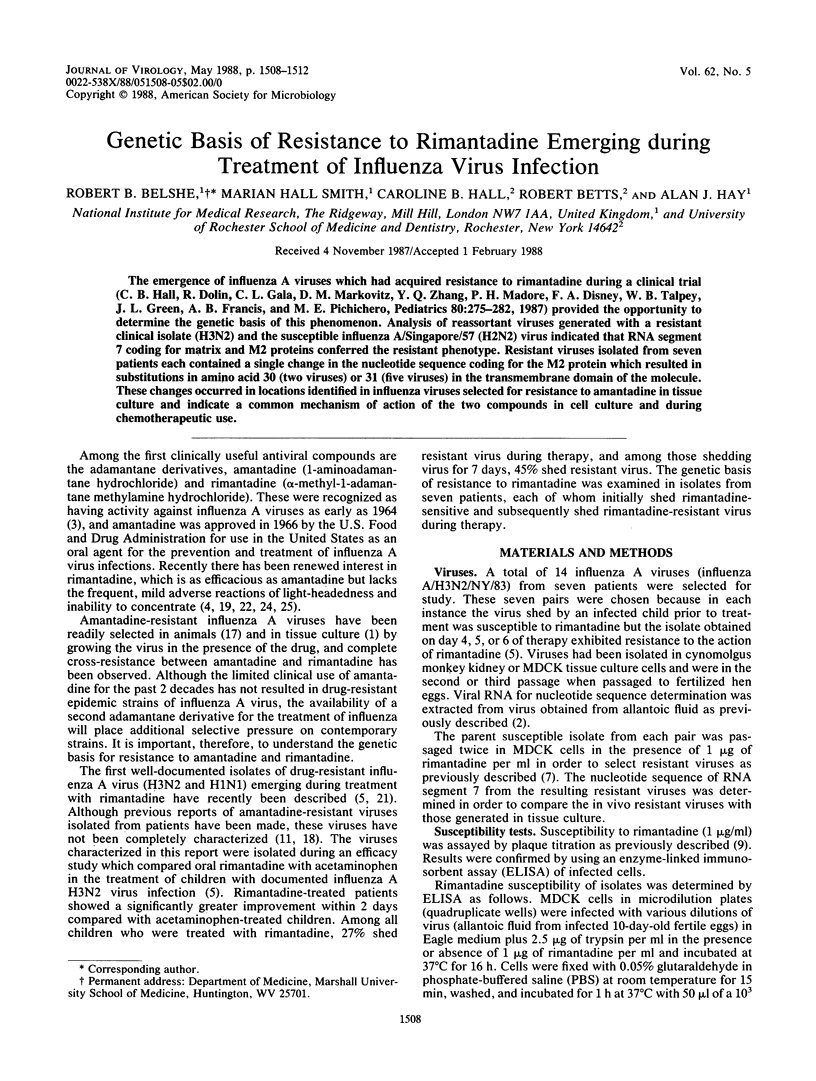
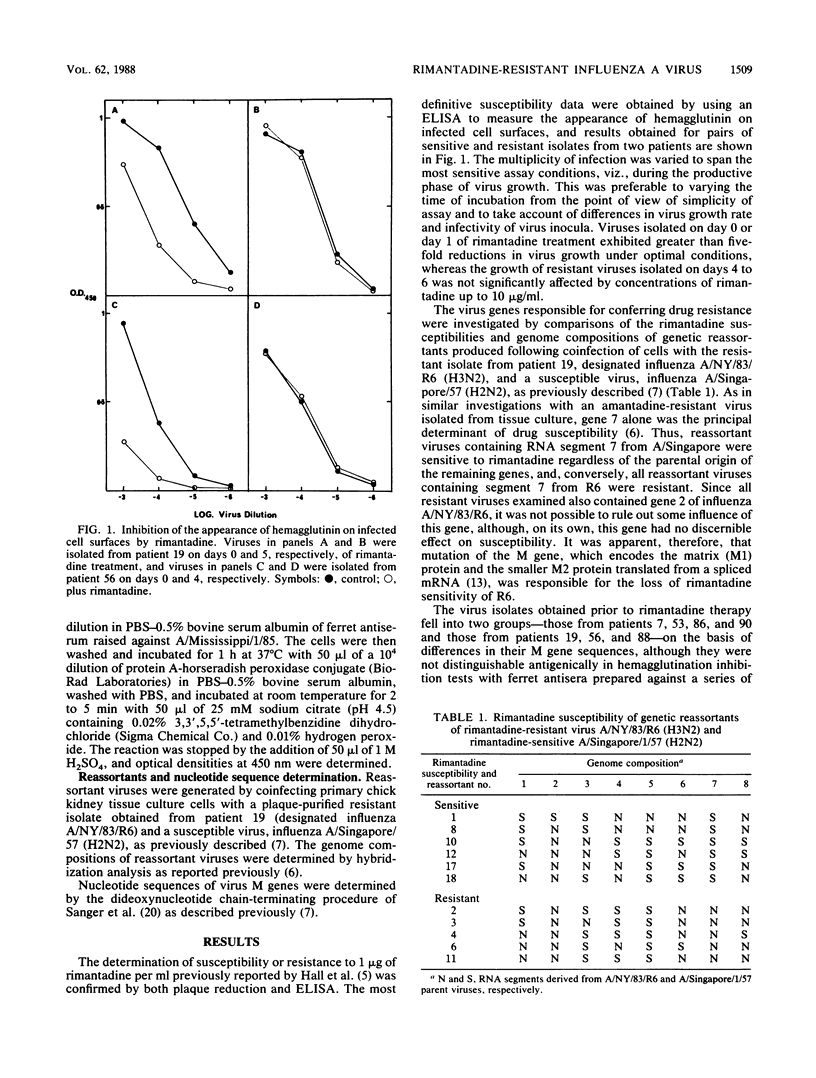
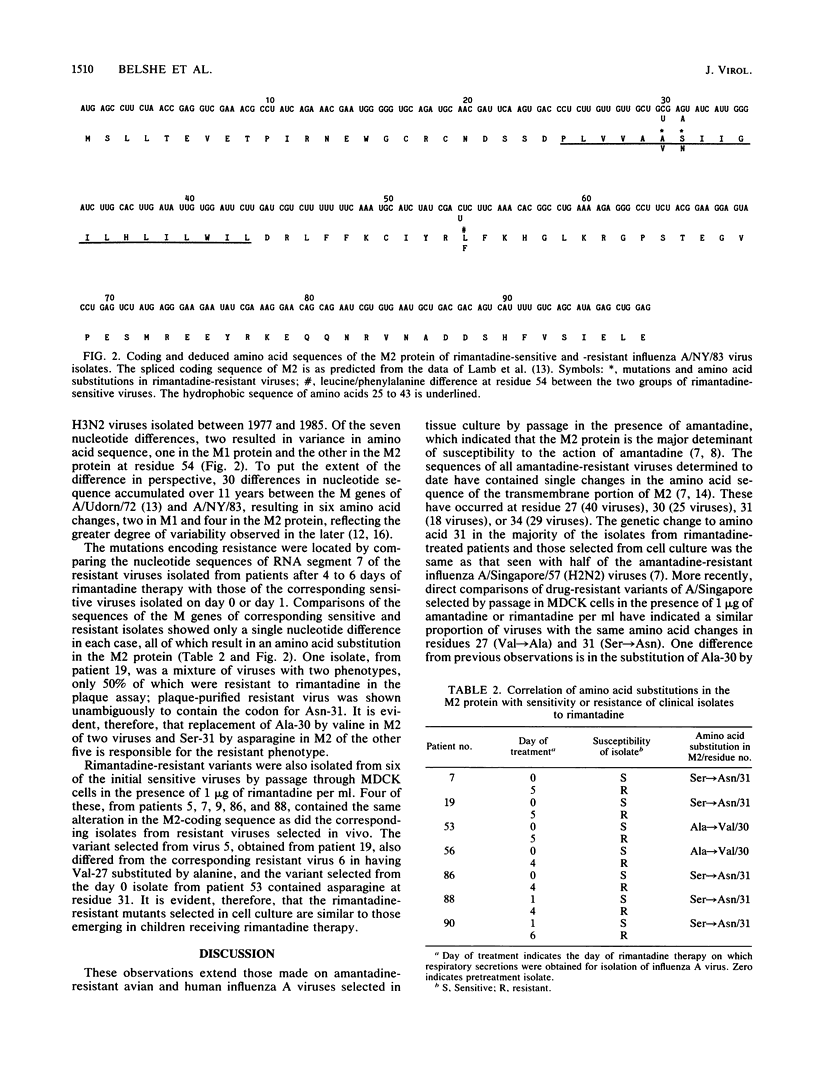
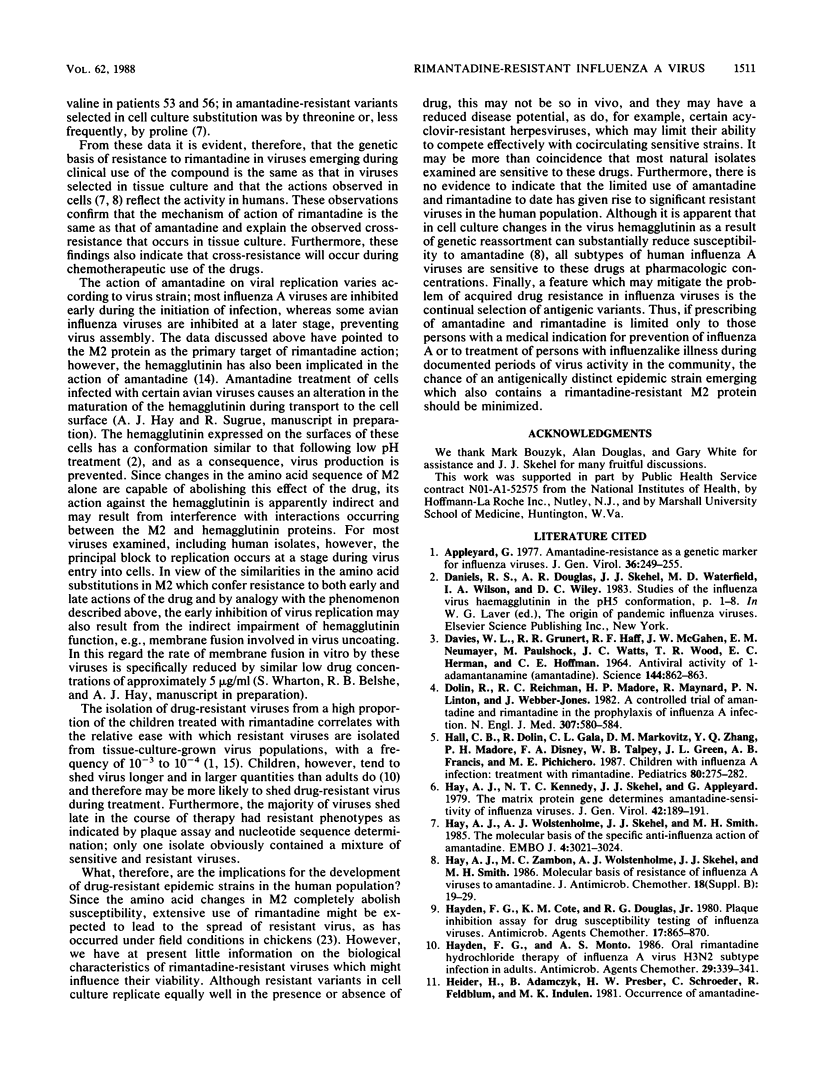
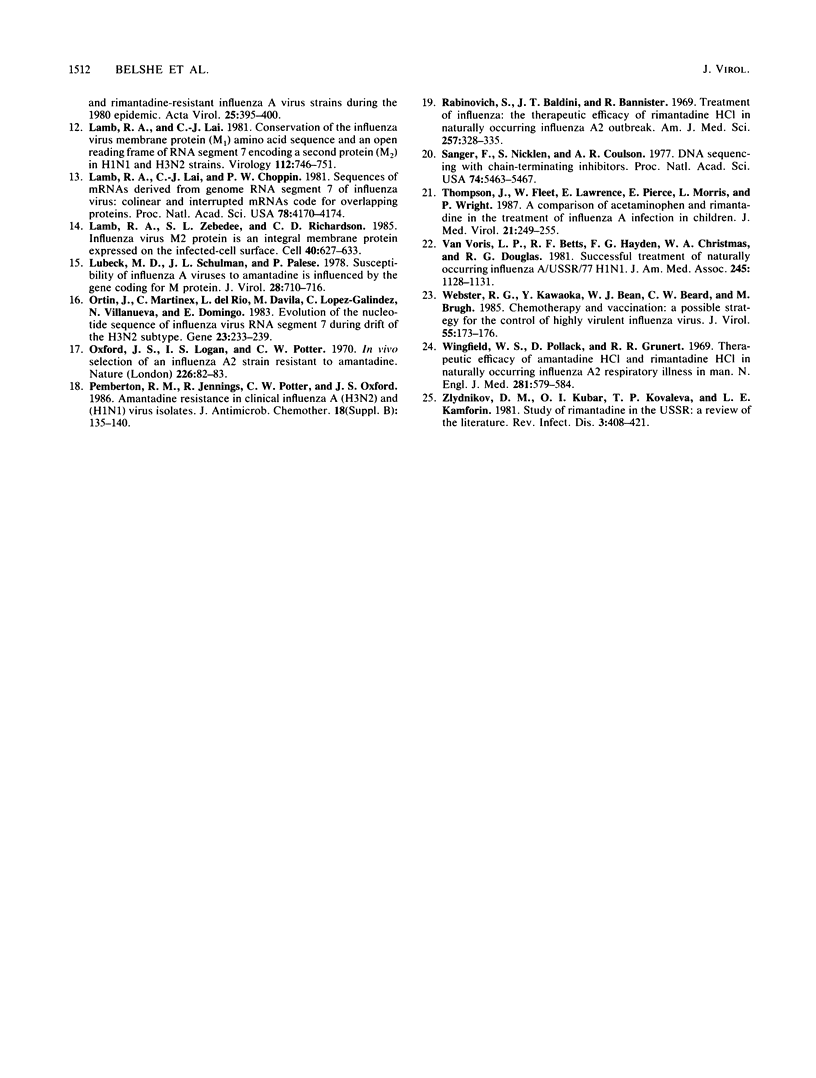
Selected References
These references are in PubMed. This may not be the complete list of references from this article.
- Appleyard G. Amantadine-resistance as a genetic marker for influenza viruses. J Gen Virol. 1977 Aug;36(2):249–255. doi: 10.1099/0022-1317-36-2-249. [DOI] [PubMed] [Google Scholar]
- DAVIES W. L., GRUNERT R. R., HAFF R. F., MCGAHEN J. W., NEUMAYER E. M., PAULSHOCK M., WATTS J. C., WOOD T. R., HERMANN E. C., HOFFMANN C. E. ANTIVIRAL ACTIVITY OF 1-ADAMANTANAMINE (AMANTADINE). Science. 1964 May 15;144(3620):862–863. doi: 10.1126/science.144.3620.862. [DOI] [PubMed] [Google Scholar]
- Dolin R., Reichman R. C., Madore H. P., Maynard R., Linton P. N., Webber-Jones J. A controlled trial of amantadine and rimantadine in the prophylaxis of influenza A infection. N Engl J Med. 1982 Sep 2;307(10):580–584. doi: 10.1056/NEJM198209023071002. [DOI] [PubMed] [Google Scholar]
- Hall C. B., Dolin R., Gala C. L., Markovitz D. M., Zhang Y. Q., Madore P. H., Disney F. A., Talpey W. B., Green J. L., Francis A. B. Children with influenza A infection: treatment with rimantadine. Pediatrics. 1987 Aug;80(2):275–282. [PubMed] [Google Scholar]
- Hay A. J., Kennedy N. C., Skehel J. J., Appleyard G. The matrix protein gene determines amantadine-sensitivity of influenza viruses. J Gen Virol. 1979 Jan;42(1):189–191. doi: 10.1099/0022-1317-42-1-189. [DOI] [PubMed] [Google Scholar]
- Hay A. J., Wolstenholme A. J., Skehel J. J., Smith M. H. The molecular basis of the specific anti-influenza action of amantadine. EMBO J. 1985 Nov;4(11):3021–3024. doi: 10.1002/j.1460-2075.1985.tb04038.x. [DOI] [PMC free article] [PubMed] [Google Scholar]
- Hay A. J., Zambon M. C., Wolstenholme A. J., Skehel J. J., Smith M. H. Molecular basis of resistance of influenza A viruses to amantadine. J Antimicrob Chemother. 1986 Oct;18 (Suppl B):19–29. doi: 10.1093/jac/18.supplement_b.19. [DOI] [PubMed] [Google Scholar]
- Hayden F. G., Cote K. M., Douglas R. G., Jr Plaque inhibition assay for drug susceptibility testing of influenza viruses. Antimicrob Agents Chemother. 1980 May;17(5):865–870. doi: 10.1128/aac.17.5.865. [DOI] [PMC free article] [PubMed] [Google Scholar]
- Hayden F. G., Monto A. S. Oral rimantadine hydrochloride therapy of influenza A virus H3N2 subtype infection in adults. Antimicrob Agents Chemother. 1986 Feb;29(2):339–341. doi: 10.1128/aac.29.2.339. [DOI] [PMC free article] [PubMed] [Google Scholar]
- Lamb R. A., Lai C. J., Choppin P. W. Sequences of mRNAs derived from genome RNA segment 7 of influenza virus: colinear and interrupted mRNAs code for overlapping proteins. Proc Natl Acad Sci U S A. 1981 Jul;78(7):4170–4174. doi: 10.1073/pnas.78.7.4170. [DOI] [PMC free article] [PubMed] [Google Scholar]
- Lamb R. A., Lai C. J. Conservation of the influenza virus membrane protein (M1) amino acid sequence and an open reading frame of RNA segment 7 encoding a second protein (M2) in H1N1 and H3N2 strains. Virology. 1981 Jul 30;112(2):746–751. doi: 10.1016/0042-6822(81)90319-6. [DOI] [PubMed] [Google Scholar]
- Lamb R. A., Zebedee S. L., Richardson C. D. Influenza virus M2 protein is an integral membrane protein expressed on the infected-cell surface. Cell. 1985 Mar;40(3):627–633. doi: 10.1016/0092-8674(85)90211-9. [DOI] [PubMed] [Google Scholar]
- Lubeck M. D., Schulman J. L., Palese P. Susceptibility of influenza A viruses to amantadine is influenced by the gene coding for M protein. J Virol. 1978 Dec;28(3):710–716. doi: 10.1128/jvi.28.3.710-716.1978. [DOI] [PMC free article] [PubMed] [Google Scholar]
- Ortín J., Martínez C., del Río L., Dávila M., López-Galíndez C., Villanueva N., Domingo E. Evolution of the nucleotide sequence of influenza virus RNA segment 7 during drift of the H3N2 subtype. Gene. 1983 Aug;23(2):233–239. doi: 10.1016/0378-1119(83)90055-0. [DOI] [PubMed] [Google Scholar]
- Oxford J. S., Logan I. S., Potter C. W. In vivo selection of an influenza A2 strain resistant to amantadine. Nature. 1970 Apr 4;226(5240):82–83. doi: 10.1038/226082a0. [DOI] [PubMed] [Google Scholar]
- Pemberton R. M., Jennings R., Potter C. W., Oxford J. S. Amantadine resistance in clinical influenza A (H3N2) and (H1N1) virus isolates. J Antimicrob Chemother. 1986 Oct;18 (Suppl B):135–140. doi: 10.1093/jac/18.supplement_b.135. [DOI] [PubMed] [Google Scholar]
- Rabinovich S., Baldini J. T., Bannister R. Treatment of influenza. The therapeutic efficacy of rimantadine HC1 in a naturally occurring influenza A2 outbreak. Am J Med Sci. 1969 May;257(5):328–335. doi: 10.1097/00000441-196905000-00005. [DOI] [PubMed] [Google Scholar]
- Sanger F., Nicklen S., Coulson A. R. DNA sequencing with chain-terminating inhibitors. Proc Natl Acad Sci U S A. 1977 Dec;74(12):5463–5467. doi: 10.1073/pnas.74.12.5463. [DOI] [PMC free article] [PubMed] [Google Scholar]
- Thompson J., Fleet W., Lawrence E., Pierce E., Morris L., Wright P. A comparison of acetaminophen and rimantadine in the treatment of influenza A infection in children. J Med Virol. 1987 Mar;21(3):249–255. doi: 10.1002/jmv.1890210308. [DOI] [PubMed] [Google Scholar]
- Van Voris L. P., Betts R. F., Hayden F. G., Christmas W. A., Douglas R. G., Jr Successful treatment of naturally occurring influenza A/USSR/77 H1N1. JAMA. 1981 Mar 20;245(11):1128–1131. doi: 10.1001/jama.245.11.1128. [DOI] [PubMed] [Google Scholar]
- Webster R. G., Kawaoka Y., Bean W. J., Beard C. W., Brugh M. Chemotherapy and vaccination: a possible strategy for the control of highly virulent influenza virus. J Virol. 1985 Jul;55(1):173–176. doi: 10.1128/jvi.55.1.173-176.1985. [DOI] [PMC free article] [PubMed] [Google Scholar]
- Wingfield W. L., Pollack D., Grunert R. R. Therapeutic efficacy of amantadine HCl and rimantadine HCl in naturally occurring influenza A2 respiratory illness in man. N Engl J Med. 1969 Sep 11;281(11):579–584. doi: 10.1056/NEJM196909112811102. [DOI] [PubMed] [Google Scholar]
- Zlydnikov D. M., Kubar O. I., Kovaleva T. P., Kamforin L. E. Study of rimantadine in the USSR: a review of the literature. Rev Infect Dis. 1981 May-Jun;3(3):408–421. doi: 10.1093/clinids/3.3.408. [DOI] [PubMed] [Google Scholar]


